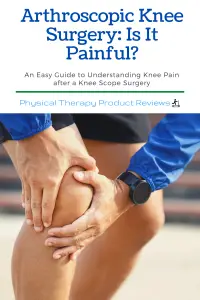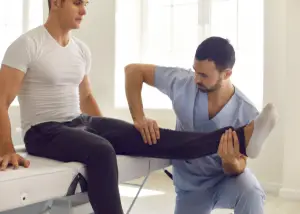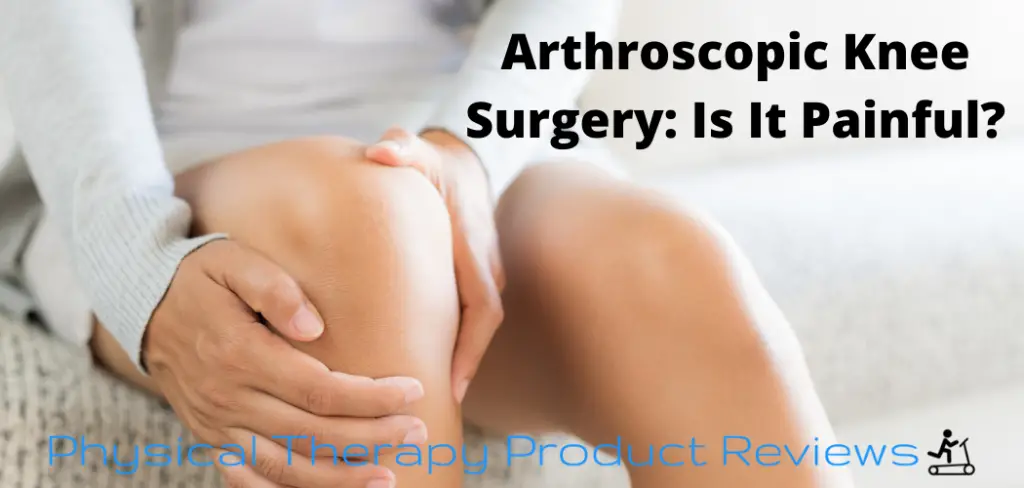Knee arthroscopy is a surgical procedure that involves the knee joint and making small incisions to repair or clean up damaged tissue. It’s typically done as an outpatient procedure with most people going home the same day and often within a few hours of surgery.
The goal of a knee scope is to reduce pain, improve joint mechanics, and fix existing tissue damage. Recovery from a knee scope is typically fairly quick and straightforward for most people.
However, it does not always eliminate all pain, and pain levels can vary from person to person. In this article, we will review how long knee pain should last after a knee scope and what you can do to help reduce your pain following this type of surgery.
Does a Knee Scope Hurt?
Yes, a knee scope can be painful but it is typically rated as mild-to-moderate. This all depends on what surgery was performed. Most people tend to have surgical pain for 2-3 days and then the pain levels improve gradually from then on.
 A knee scope is an outpatient surgery, but that doesn’t mean it’s pain-free. In general, knee pain after a knee scope can range from mild to severe and it typically depends on the type of surgery you had done as well as what part of your knee was worked on. Common knee scope surgeries include a partial meniscectomy, a cartilage debridement, removal of a loose fragment, and even an ACL reconstruction.
A knee scope is an outpatient surgery, but that doesn’t mean it’s pain-free. In general, knee pain after a knee scope can range from mild to severe and it typically depends on the type of surgery you had done as well as what part of your knee was worked on. Common knee scope surgeries include a partial meniscectomy, a cartilage debridement, removal of a loose fragment, and even an ACL reconstruction.
Patients who experience low levels of pain typically have less performed on their knee such as a Meniscectomy, have a lower BMI, and a previously active lifestyle.
The level of discomfort also varies depending on how active you are in your daily life. The more active and stronger someone is before surgery then they are less likely to have high levels of pain after surgery.
People who experience higher levels of pain typically have more arthritis built up in the joint, are overweight or obese, and may have multiple things wrong in the knee joint.
How Long Does Pain Last After a Knee Arthroscopy?
Most knee pain from a knee scope should improve within the first week after surgery, but it can take up to 3 months for it to go away for some people. For most people, the pain is improved and nearly back to normal within 6 weeks from surgery.
Pain is highest within 1-2 days of surgery and is most notable when the anesthesia from surgery wears off.
After the higher levels of pain levels are reached 2-3 days after surgery, it should begin to progress to mild and dull achy pain. You may still have high levels of pain with certain activities the longer your knee has had time to heal.
Is Pain Normal 3 Months After a Knee Arthroscopy?
Yes, knee pain can be normal for up to three months after knee surgery. This depends on how much work was done during surgery, however you may still have pain with running, jumping, and deep squatting. If you’ve had ACL surgery, then pain 3-months later is still quite expected.
Even though the meniscus and other tissues have been “cleaned up,” there may still be other issues in the joint that can cause swelling and weakness. Until the knee and surrounding muscles get stronger, there is a good chance that you can have pain and achiness with demanding activities.
Does a Knee Scope Increase Knee Pain?
In general knee pain after a knee scope is not increased by the surgery itself in the long term. Sure, there are higher levels of pain in the first few days after surgery but then the pain should continue to improve.
However, knee arthroscopy can be more difficult to recover from if you have advanced knee osteoarthritis or other medical conditions that affect the overall health of your knee. In this case, it may take longer for knee pain to improve after knee surgery.
Tips for Reducing Pain After a Knee Arthroscopy
If you are experiencing pain after a knee scope or are worried about pain after knee surgery then there are a few things that you can do to decrease the pain.
Walk as Much as you Can
The knee is designed to move and you should do your best to keep it moving. This will help prevent scar tissue build up, swelling in the knee joint, and improve circulation.
If walking is painful early on after surgery, be sure to use crutches until you can walk as close to pain-free as possible. The more you use the knee the better that it will feel.
Go to Physical Therapy
Physical therapy is a great way to improve knee strength and knee stability after surgery. Taking the time to do physical therapy exercises will help you get back your knee function as soon as possible and reduce pain levels in the long run.
Not only this, but it can also teach you how to properly walk with crutches and how to improve your gait after treatment.

Believe it or not, there is a handful of surgeons that don’t prescribe physical therapy after a knee scope. We recommend at least going for a few visits to make sure that you are on the right path.
Get Full Knee Extension First
Knee pain can be caused by muscle contractures or scar tissue build-up in the knee.
Full knee extension is key for reducing knee pain after surgery, so do what you can to get full motion back as soon as possible. This means that before doing things like walking around your home and stairs, make sure that you are able to straighten your knee completely.
Walking on the knee with a knee bend will be painful and increase swelling of the knee, so it is important to focus on knee extension or getting it fully straight early in the recover.
Focus on Quad Strength
Strengthening your knee is important after surgery, but it is especially important to strengthen the quadriceps muscles. Strengthening these important muscles helps improve knee stability and reduce knee pain. The quadriceps control 60% of the function of the knee so the stronger that it is the more stable your knee will be.
Quad sets are a great exercise for starting out knee strengthening exercises after knee surgery and can be performed within a few days. Mini squats and lunges are a great way to strengthen the quad once your knee can tolerate the activities.

Wear a Compression Sleeve if you Still Have Swelling
It can be annoying to wear knee compression sleeves after knee surgery, but it is a great way to reduce knee swelling and pain. This is especially true after surgery when pain and swelling are most prevalent.
Even if you don’t feel like you have much knee swelling anymore, wearing a knee sleeve will help if you have to return to work before your knee is ready or you are trying to back to a sport with less pain.
FAQ About Knee Scopes
Why does my shin hurt after a Knee Scope?
This is a very common knee surgery symptom and can be caused by muscle cramping and tightness. These muscles may be trying to compensate for the knee and this causes an overload on the shin muscles.
Swelling can also fall down into the shin and lower leg. This can cause pain and compression in the lower leg and lead to pain.
Do knee scopes cause knee arthritis?
A knee scope does not directly cause knee arthritis but there is some research that shows it may speed up the process of having knee arthritis. This is especially true if you have a partial meniscectomy which removes some of the torn cartilage in the knee. The area that the town cartilage may feel better initially but in the long term leaves it susceptible to knee arthritis build up.
Why is there pain behind my knee with a Knee Scope?
This is knee swelling and it typically goes away within a few weeks after knee surgery. If you still experience this behind your knee even up to six months, try wearing a knee compression sleeve because it will help reduce the amount of fluid build-up in the knee joint.
This can also be due to tight hamstring muscles in the back of knee that are pulling on the knee joint and causing pain behind knee. This is a common problem after knee surgery because this muscle group often overcompensates after surgery.
Why is there Bruising in my shin after a knee scope?
This can be normal after surgery depending on the surgery. If you had a meniscectomy this can just be bruising falling down the leg into the shin and should go away quickly. If it doesn’t you should let your doctor know.
If you had an ACL surgery, then the surgeon has to drill a hole in the top of the shin bone for the new ligament graft. This can cause bruising to accumulate in the shin bone.
Pain in the Calf After a Knee Scope?
Swelling and knee pain in the calf after knee surgery can be normal but it can also signal other issues. Be on the lookout for a blood clot in the calf muscle. Signs of a blood clot include:
- pain in the knee or calf that does not go away
- redness of the skin overlying the calf muscle
- tightness and discomfort with calf compression
- shortness of breath with activity
If you notice any of these symptoms contact your doctor immediately. You may need to take blood thinners if it is determined you have a blood clot.
Conclusion
Knee arthroscopy Surgery is minimally invasive knee surgery that can be used to diagnose knee pain as well as provide treatment for certain knee conditions.
It is important to talk with your knee surgeon so they can provide you with the best advice for knee pain after surgery.
Knee arthroscopy Surgery does not always cause knee arthritis and in some cases it actually helps reduce knee symptoms like knee pain up into three months following a knee scope.
However, if you still have knee pain after knee surgery, it is important to talk with your doctor about the different knee surgeries that could be done for knee pain relief.
Excellent Physical Therapy Articles
How to Stay Active After Cervical Fractures: Expert Tips and Advice
Dealing with Painful Stairs After Ankle Replacement Surgery
Walking After a Total Ankle Replacement: Tips for a Successful Recovery
Exercises While Non-Weight Bearing After Ankle Replacement: Elevation, AROM, Leg Raises, and More
Ankle Pain with Stairs: Causes and Home Treatment Options
5 Common Mistakes You’re Making After an Ankle Sprain
Disclaimer: The information provided in this post is for educational purposes only. This is not a substitute for a medical appointment. Please refer to your physician before starting any exercise program.







